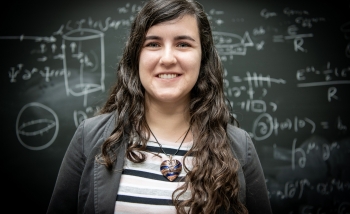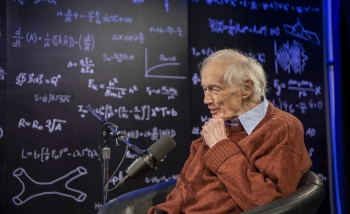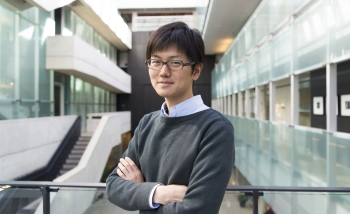Meet Carlo Rovelli. He wants to turn black holes inside out.
You may have heard of Rovelli already. He’s the author of one of the most famous popular science books of all time: Seven Brief Lessons on Physics. The book distills modern physics into 100 charming pages, has been published in 41 languages, and has sold more than a million copies.
Or you may know Rovelli as one of the founders of loop quantum gravity, a leading candidate theory in the 80-year quest to unite general relativity (GR) with quantum mechanics.
As both writer and researcher, Rovelli keeps busy. He’s published two more books since Seven Brief Lessons and has another in the works. His continuing work on loop quantum gravity has been nothing short of field-defining.
How does he balance it? “Badly,” he says, with a laugh. “I work on all sorts of things, and that's my problem. But the main thing that's in my head is a black- to white-hole transition.
“A white hole,” Rovelli explains, “is kind of the opposite of a black hole. Instead of things falling in, they come out.”
Rovelli believes that black holes become white holes as they age. In the end, he says, “everything that fell into the black hole is going to come out the white hole.” He and his collaborators “are working on the theory of that, and the astrophysics of that, and the cosmology of that. We're trying to see if these white holes can be visible in the universe – if we can observe them.”
Taking loop quantum gravity inside a black hole
Rovelli’s journey to white hole physics has been a long and winding one.
“I started loop quantum gravity with Lee Smolin in the ’80s,” Rovelli remembers. “A big part of my life I’ve worked in building up the theory and contributing to make it work. And now we have this big theory which is nice and beautiful and everything, but we want to use it for something. We want to connect it to things we can see in the universe.”
Black holes, he says, were the obvious place to look. That’s because loop quantum gravity is an attempt to unite general relativity with quantum mechanics, and black holes are one place where physicists must use both theories at the same time.
Quantum mechanics says the universe is built from pieces that have a certain minimum size, much like an image is made of pixels. At everyday scales – the scales of chairs and tables – things look smooth, but zoom in far enough, and the pixelation becomes obvious. These pixels – these smallest possible pieces – are called quanta, which is just the plural of quantum, the Latin for “piece.”
General relativity, on the other hand, is a theory of gravity. It says that space and time aren’t empty somethings through which gravity spreads: rather, spacetime is gravity itself. It’s a kind of fabric, stretching and curving where there is mass, and coaxing that mass to move along those curves.
General relativity is a successful theory, but it’s not a quantum theory: no matter how far you zoom into the fabric of GR spacetime, you won’t see its stitches. No pixelation appears. Many physicists believe that to unite GR with quantum mechanics, we must find some ‘quantum’ of spacetime, some smallest possible piece of gravity. Loop quantum gravity is a theory in which the quanta of spacetime are Planck-scale loops of gravitational fields.
Consider that in the context of black holes. GR predicts that when a spent star collapses under its own weight, it changes the curve of the spacetime around it.
Students learning about relativity are often urged to picture the star as a bowling ball and spacetime as a rubber sheet: as the star collapses, the bowling ball becomes softball-sized, then tennis ball-sized, then marble-sized, all while weighing as much as the bowling ball did. The sag the heavy marble produces is different than the one the bowling ball produced: narrower, but steeper. At a certain point, it becomes so steep that nothing, not even light, has the momentum to get up the slope.
The point where the slope gets that steep is known as the event horizon. We can’t see what’s happening beyond that horizon, because no signals can top the slope. The traditional prediction of general relativity is that the star continues to shrink. Hidden behind the event horizon, spacetime continues to curve tighter and tighter, like a funnel, until the star is infinitely dense and spacetime is infinitely curved. This point is called the singularity, and it’s like a place where the universe is divided by zero: the laws of physics make no sense there.
Rovelli, like many other physicists, believes that before the spacetime funnel narrows to a point, quantum effects take over. If spacetime itself has a minimum size, then gravity can’t curve more tightly than that minimum size. The quantum effects prevent the singularity from forming.
But what happens instead?
A quantum bounce changes a black hole to a white hole
When a star collapses, says Rovelli, spacetime inside the horizon curves in and down: “You get a well, a tube, that becomes longer and longer and longer with time. It keeps growing, growing, growing.” At a certain point, he calculates, the system hits a quantum limit on how deep and narrow the tube can grow. And when it does, it bounces. The black hole, Rovelli says, becomes a white hole.
“A white hole is the opposite of a black hole,” he says. “It’s a tube growing shorter – a mass coming back. If you imagine filming a black hole forming, and then running the film backward, that’s a white hole.”
When the bottom of the tube reaches the event horizon, everything that ever went into the black hole comes back out. In short, it explodes.
This, it should be noted, is a minority view. Though white holes are certainly a mathematical solution to the equations of general relativity, most physicists are convinced that white holes don’t exist in nature. Rovelli is not so sure.
“White holes are not a novelty. They are predicted by the theory of Einstein. No one believes that they are real in the universe, but also, black holes – no one believed they were real in the universe, so I suspect we might be telling the same story. First, there’s a funny object described theoretically, and then people start thinking, ‘Wait a minute – that could actually be real.’ With black holes, it happened that they are real. I think that it might be the same with white holes.”
Observing white holes
What would a white hole look like? For most of its life, exactly the same as a black hole: the differences would all be hidden behind the horizon. But at the end of its life, a white hole would look like an explosion – an explosion we might be able to spot.
For several years, Rovelli and colleagues have been trying to decide what that explosion might look like.
They have several hypotheses, including one connecting white hole transitions to fast radio bursts, and one connecting white holes to dark matter. “We don’t know yet,” he says. “But let me tell you the best thing about this story.
“A star collapses and forms a black hole, and for a very long time stays there – maybe billions of years later it becomes a white hole. But imagine falling into a black hole. You would fall very rapidly through the transition [to a white hole], and very rapidly you come out. Your time is less than a millisecond. Outside the time is billions of years.”
This is possible, he says, because general relativity says time passes more quickly near large masses. “General relativity says there is more time in the mountains than in the plains,” Rovelli explains. “This is the same effect, except the difference is not a fraction of a second every few hundred years, like the difference between the mountains and the plains. It’s an enormous difference.
“If this story is correct, then what a black hole is, is a kind of short cut to the future. You can fall in, and – zwoop! – come out in the future immediately after.”
Consider the case of primordial black holes, the as-yet-unobserved class of black holes thought to have formed in the first fraction of a second after the big bang. If Rovelli’s black-hole-to-white-hole hypothesis is true, and if the timing works out, then primordial black holes may be reaching the white-hole-explosion end of their lives about now.
“If these holes formed in the early universe, then what fell in was very hot,” says Rovelli. “So when they explode, what comes out is very-high-energy photons.”
This, he says, could be the source of the mysterious very-high-energy cosmic rays that strike the Earth with billions of times the energy of our best particle colliders.
A new role
Black holes, white holes, explosions, time travel – it’s quite a story. But with Rovelli, it’s in the hands of one of the best storytellers in physics. And though he thinks of white holes as a promising line of research, he’s also got that new book to write. And the entire field of loop quantum gravity to keep up with. And colleagues and friends to talk to. “I love all of it,” he says. “All of it. I should perhaps do less, but – who could bear it?”
Naturally, then, Rovelli recently chose to take on yet another role: as one of Perimeter Institute’s Distinguished Visiting Research Chairs (DVRCs). DVRCs are eminent scientists who make extended research visits to Perimeter while retaining permanent positions at their home institutions – in Rovelli’s case, Aix-Marseille University in France.
“I think I’m going to be spending quite some time at Perimeter. There are a lot of people here with whom I can work,” he says. “Especially, there are a lot of young people.”
Delighted, he recounts how he arrived in the building at 10 am and didn’t reach his office until 2 pm: “I had one student after another just come in and see me, talk about what they are doing, and they had great ideas. It’s very lively here. I think I will fit in."
About PI
Perimeter Institute is the world’s largest research hub devoted to theoretical physics. The independent Institute was founded in 1999 to foster breakthroughs in the fundamental understanding of our universe, from the smallest particles to the entire cosmos. Research at Perimeter is motivated by the understanding that fundamental science advances human knowledge and catalyzes innovation, and that today’s theoretical physics is tomorrow’s technology. Located in the Region of Waterloo, the not-for-profit Institute is a unique public-private endeavour, including the Governments of Ontario and Canada, that enables cutting-edge research, trains the next generation of scientific pioneers, and shares the power of physics through award-winning educational outreach and public engagement.
You might be interested in


